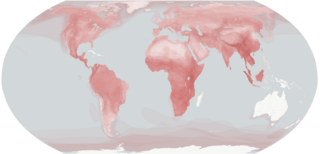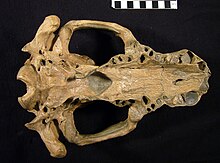
Carnivora is an order of placental mammals that have specialized in primarily eating flesh, whose members are formally referred to as carnivorans. The order Carnivora is the fifth largest order of mammals, comprising at least 279 species.

The order Peramelemorphia includes the bandicoots and bilbies. All members of the order are endemic to Australia-New Guinea and most have the characteristic bandicoot shape: a plump, arch-backed body with a long, delicately tapering snout, very large upright ears, relatively long, thin legs, and a thin tail. Their size varies from about 140 grams up to 4 kilograms, but most species are about one kilogram.

The dire wolf is an extinct canine. The dire wolf lived in the Americas during the Late Pleistocene and Early Holocene epochs. The species was named in 1858, four years after the first specimen had been found. Two subspecies are recognized: Aenocyon dirus guildayi and Aenocyon dirus dirus. The largest collection of its fossils has been obtained from the Rancho La Brea Tar Pits in Los Angeles.

A saber-tooth is any member of various extinct groups of predatory therapsids, predominantly carnivoran mammals, that are characterized by long, curved saber-shaped canine teeth which protruded from the mouth when closed. Saber-toothed mammals have been found almost worldwide from the Eocene epoch to the end of the Pleistocene epoch.

Caniformia is a suborder within the order Carnivora consisting of "dog-like" carnivorans. They include dogs, bears, raccoons, and mustelids. The Pinnipedia are also assigned to this group. The center of diversification for the Caniformia is North America and northern Eurasia. Caniformia stands in contrast to the other suborder of Carnivora, the Feliformia, the center of diversification of which was in Africa and southern Asia.

Nimravidae is an extinct family of carnivorans, sometimes known as false saber-toothed cats, whose fossils are found in North America and Eurasia. Not considered to belong to the true cats, the nimravids are generally considered closely related and classified as a distinct family in the suborder Feliformia. Fossils have been dated from the Middle Eocene through the Late Miocene epochs, spanning about 33.2 million years.

Thylacosmilus is an extinct genus of saber-toothed metatherian mammals that inhabited South America from the Late Miocene to Pliocene epochs. Though Thylacosmilus looks similar to the "saber-toothed cats", it was not a felid, like the well-known North American Smilodon, but a sparassodont, a group closely related to marsupials, and only superficially resembled other saber-toothed mammals due to convergent evolution. A 2005 study found that the bite forces of Thylacosmilus and Smilodon were low, which indicates the killing-techniques of saber-toothed animals differed from those of extant species. Remains of Thylacosmilus have been found primarily in Catamarca, Entre Ríos, and La Pampa Provinces in northern Argentina.
Potamotherium an extinct genus of caniform carnivoran from the Miocene epoch of France and Germany. It has historically been assigned to the family Mustelidae, but more recent studies suggest that it represents a primitive relative of pinnipeds

Phlaocyon is an extinct genus of the Borophaginae subfamily of canids native to North America. It lives from the Early Oligocene to the Early Miocene epoch 33.3–16.3 Mya, existing for approximately 17.3 million years. It is closely related to Cynarctoides.

Desmatophoca is an extinct genus of early pinniped that lived during the Miocene, and is named from the Greek "phoca", meaning seal. A taxon of the family Desmatophocidae, it shares some morphological similarities with modern true seals. Two species are recognized: Desmatophoca oregonensis and Desmatophoca brachycephala. Little information exists regarding Desmatophoca, due to the small number of fossil samples obtained and identified.

Ursoidea is a superfamily of arctoid carnivoran mammals that includes the families Subparictidae, Amphicynodontidae, and Ursidae which the last family includes the extant lineages of bears as well the extinct Hemicyoninae and Ursavinae. The interrelationships of ursoids has had slight arrangements. In the past it was thought the extinct Amphicyonidae were stem-bears based on morphological analysis of the ear region, though the most recent publications on early amphicyonids suggests they were basal caniforms. The amphicynodontids are sometimes classified as either a subfamily of bears, a paraphyletic assemblage of early bears, or even stem-pinnipeds. The subparictids were previously classified as amphicynodontine/ids. The hemicyonines have been occasionally reclassified as a separate family.
Nothocyon is an extinct genus of carnivoran in the family Subparictidae which inhabited North America during the late Oligocene. At one time, many species of the dog family Canidae were placed in Nothocyon, but new fossils showed that the type species of Nothocyon, N. geismarianus, is more closely related to bears. The other species have been reassigned to other genera such as Cormocyon.

Puijila darwini is an extinct species of stem-pinniped which lived during the Miocene epoch about 21 to 24 million years ago. Approximately a metre in length, the animal possessed only minimal physical adaptations for swimming. Unlike modern pinnipeds, it did not have flippers and its overall form was otter-like, albeit more specialized; its skull and teeth are the features that most clearly indicate that it is a seal.

Pontolis is an extinct genus of large walrus. It contained three species, P. magnus, P. barroni, and P. kohnoi. Like all pinnipeds, Pontolis was a heavily built amphibious carnivore. Pontolis lived along the Pacific coast of North America along what is now the western coasts of California and Oregon between 11.608 and 5.332 million years ago, during the Miocene and Pliocene.

Hyaenodonta is an extinct order of hypercarnivorous placental mammals of clade Pan-Carnivora from mirorder Ferae. Hyaenodonts were important mammalian predators that arose during the early Paleocene in Europe and persisted well into the late Miocene.
Siamogale melilutra is an extinct species of giant otter from the late Miocene from Yunnan province, China.

Amphicynodontidae is a probable clade of extinct arctoids. While some researchers consider this group to be an extinct subfamily of bears, a variety of morphological evidence links amphicynodontines with pinnipeds, as the group were semi-aquatic otter-like mammals. In addition to the support of the pinniped–amphicynodontine clade, other morphological and some molecular analyses support bears being the closest living relatives to pinnipeds. According to McKenna and Bell (1997) Amphicynodontinae are classified as stem-pinnipeds in the superfamily Phocoidea. Fossils of these mammals have been found in Europe, North America and Asia. Amphicynodontines should not be confused with Amphicyonids (bear-dogs), a separate family of Carnivora which is a sister clade to arctoids within the caniforms, but which may be listed as a clade of extinct arctoids in older publications.
Subparictidae is an extinct family of early Paleogene arctoid carnivorans endemic to North America that closely related to bears. They were small, raccoon-like mammals that lived from the Eocene to the early Miocene. This family includes a handful of genera such as Subparictis, Parictis, Nothocyon, and Eoarctos.

Atopotarus is an extinct genus of pinniped from the middle Miocene known from one specimen from Los Angeles County, California. It belongs to the extinct family Desmatophocidae, an early lineage of seal-like pinnipeds from the North Pacific.





















